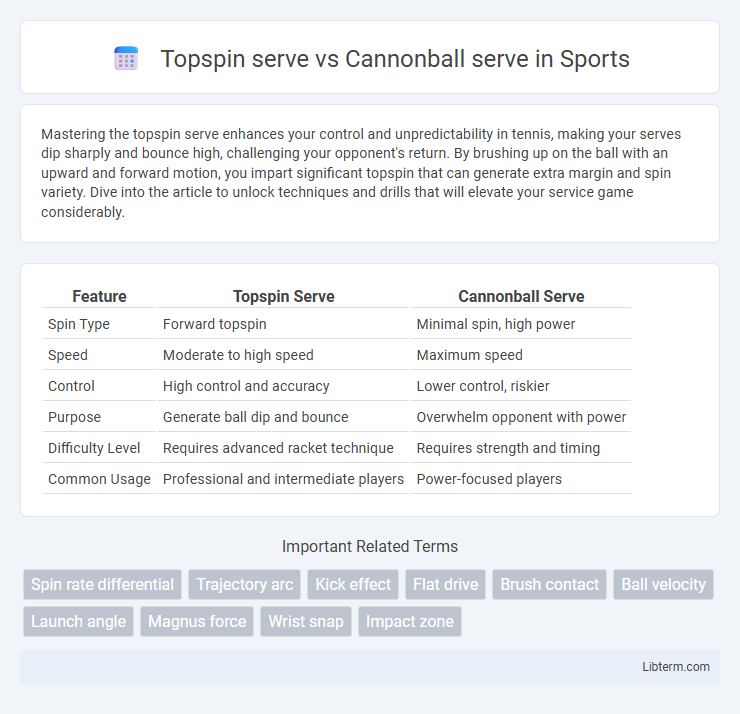Mastering the topspin serve enhances your control and unpredictability in tennis, making your serves dip sharply and bounce high, challenging your opponent's return. By brushing up on the ball with an upward and forward motion, you impart significant topspin that can generate extra margin and spin variety. Dive into the article to unlock techniques and drills that will elevate your service game considerably.
Table of Comparison
| Feature | Topspin Serve | Cannonball Serve |
|---|---|---|
| Spin Type | Forward topspin | Minimal spin, high power |
| Speed | Moderate to high speed | Maximum speed |
| Control | High control and accuracy | Lower control, riskier |
| Purpose | Generate ball dip and bounce | Overwhelm opponent with power |
| Difficulty Level | Requires advanced racket technique | Requires strength and timing |
| Common Usage | Professional and intermediate players | Power-focused players |
Introduction to Topspin and Cannonball Serves
The Topspin serve generates high rotational speed on the ball, causing it to dip sharply and bounce aggressively, making it difficult for opponents to return. In contrast, the Cannonball serve emphasizes raw power and speed, delivering a fast, low trajectory shot that overwhelms the receiver with velocity. Both serves are fundamental techniques in competitive tennis, with Topspin focusing on control and spin, while Cannonball prioritizes force and speed.
Key Differences Between Topspin and Cannonball Serves
Topspin serves generate a high rotation on the ball, causing it to dip sharply and bounce higher, which makes it difficult for opponents to predict and return effectively. Cannonball serves rely on sheer speed and flat trajectory, focusing on power to overpower the receiver rather than spin-induced movement. The key differences lie in the spin and speed: topspin emphasizes controlled, spin-driven placement, while cannonball prioritizes aggressive, high-velocity shots.
Technique Breakdown: Executing a Topspin Serve
Executing a topspin serve requires a precise grip, typically the continental grip, allowing for maximum wrist snap to generate forward spin on the ball. The racket must brush upward against the ball during contact, creating the characteristic spin that causes the ball to dip quickly and bounce high upon landing. Proper body rotation, coupled with a coordinated toss slightly ahead of the hitting shoulder, optimizes power and control distinct from the more forceful flat trajectory of the cannonball serve.
Technique Breakdown: How to Execute a Cannonball Serve
The Cannonball serve requires a pronounced downward toss, followed by a rapid wrist snap to produce heavy topspin and a sharp bounce. Proper foot placement involves a staggered stance with the body leaning slightly forward to maximize power and control. Consistent practice of the shoulder rotation and precise ball contact ensures the Cannonball serve generates unpredictable spin and speed, making it a formidable weapon in competitive table tennis.
Spin Dynamics: The Science Behind Each Serve
Topspin serves generate forward rotational force by brushing up the ball, creating high Magnus effect that results in a dipping trajectory and increased bounce on landing. Cannonball serves rely on minimal spin and maximum velocity, producing a flatter trajectory with greater speed but less control and lower bounce height. Understanding spin dynamics reveals how topspin enhances control and deception, while cannonball serves prioritize power and speed to overwhelm opponents.
Power and Speed Comparison
The Topspin serve generates moderate power with a focus on high spin rate, enhancing ball control and bounce, typically reaching speeds of 70-90 mph. The Cannonball serve emphasizes raw power and speed, often exceeding 90 mph, sacrificing spin for a more aggressive, fast trajectory. While the Topspin serve leverages enhanced ball rotation to challenge opponents' returns, the Cannonball serve relies on sheer velocity to overpower receivers quickly.
Control and Accuracy: Which Serve Offers More Precision?
The Topspin serve offers greater control and accuracy due to its spin, which causes the ball to dip sharply and bounce unpredictably, making it easier to target specific areas on the opponent's court. The Cannonball serve relies on raw power and speed, often sacrificing precision for velocity, resulting in a higher risk of errors. Players seeking precision and consistent placement typically prefer the Topspin serve for its enhanced ability to maintain control over the ball's trajectory.
Suitable Playing Conditions for Each Serve
The Topspin serve excels in conditions with moderate to high humidity and slower court surfaces, such as clay, where its heavy spin can generate unpredictable ball bounce, challenging opponents' returns. In contrast, the Cannonball serve performs best on faster surfaces like grass or indoor hard courts, where speed and low trajectory can overpower opponents before they can react. Players should consider court speed and environmental factors when choosing between the Topspin serve's spin advantage and the Cannonball serve's raw power.
Common Mistakes and How to Avoid Them
The Topspin serve often suffers from improper wrist snap and insufficient upward ball brushing, leading to reduced spin and control, while the Cannonball serve frequently encounters excessive arm tension and poor ball toss positioning, causing inconsistent power and accuracy. Common mistakes include failing to maintain a relaxed grip in the Topspin serve and neglecting the body's rotational force in the Cannonball serve. To avoid these errors, players should practice a fluid wrist motion for the Topspin serve and focus on a stable, well-timed ball toss combined with core engagement for the Cannonball serve.
Choosing the Right Serve for Your Playing Style
Choosing the right serve, such as the Topspin serve or Cannonball serve, depends on your playing style and match strategy. Topspin serves offer heavy spin and control, ideal for players who prefer consistent ball placement and setting up offensive shots. Cannonball serves deliver powerful speed and minimal spin, suitable for aggressive players aiming to pressure opponents with fast, forceful serves.
Topspin serve Infographic

 libterm.com
libterm.com